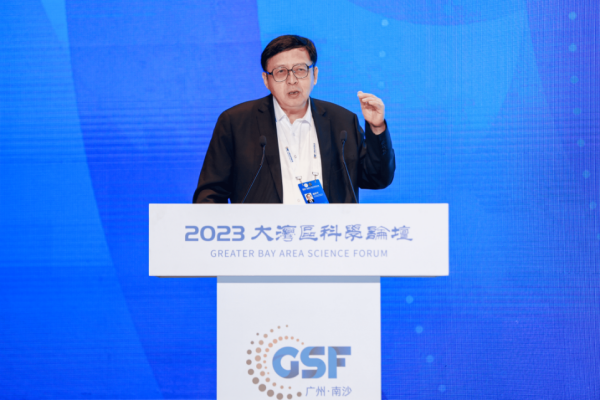Mu Rongping: Nansha Science City and the Rebirth of Urban Innovation Genes
Last June, the State Council issued the "Overall Plan for Promoting Comprehensive Cooperation among Guangdong, Hong Kong and Macao by Further Deepening Opening-up in Nansha District of Guangzhou" (referred to as "the Nansha Plan"), which called for the high-level construction of Nansha Science City. In February, the Guangdong provincial government approved the overall development plan for Nansha Science City, ushering in new strategic opportunities for scientific and technological innovation in Nansha.

Mu Rongping, director of the Center for Innovation and Development, CAS, delivers a report at the 2023 Greater Bay Area Science Forum. [Photo/gsf.org.cn]
At the recently concluded 2023 GSF's session on the development of Nansha Science City and regional coordinated development, Mu Rongping, planner and drafter of the development blueprint for Nansha Science City, delivered a speech entitled "Promoting Development through Innovation, Leading the Future with Science and Technology: Nansha Science City and the Rebirth of Urban Innovation Genes". The following is an excerpt from his speech:
"Innovation-driven, digital transformation and sustainable development" is a global trend.
The core competitiveness in science is a new decisive factor in maintaining national security. Over the past decades, China has taken digital transformation as a key strategy. The 14th Five-Year Plan (2021-25) emphasized the "digital China" concept and the country's digital development blueprint also highlights the digital culture and digital ecological civilization.
Nurturing urban innovation genes is the first mission of Nansha Science City.
Innovation is a complex process of value creation in such fields as science, technology, economy, culture and society, involving scientific discovery, technological invention, method innovation and its commercial application and social promotion activities.
The difference between developed and developing countries is mainly value creation. Therefore, it is necessary to consider the positioning and layout of Nansha Science City.
Since the beginning of reform and opening-up, Guangdong has focused on manufacturing factories in areas such as technological application as well as production system construction, and attracting more Fortune Global 500 companies. However, traditional factory development models are unlikely to lead future development in an era where labor costs keep rising. Therefore, it is urgent for us to build a regional engine for innovative development on the basis of the existing regional economic foundation, and the core of this engine is to build Nansha Science City.
Vision leads Nansha Science City in driving regional sustainable development.
The planning for Nansha Science City focuses on four visions: global innovation, intelligent manufacturing, digital services, and green environment.
With a focus on capacity building, we need to take comprehensive innovation and reforms as the driving force to create an institutional and cultural environment that enables global talents to achieve their dreams in innovation and entrepreneurship and build large-scale science infrastructure clusters and scientific talent teams.
One of the most important features of Nansha is its role as a global innovation center for marine science and engineering. Besides the South China Sea Institute of Oceanology of the Chinese Academy of Sciences, Guangzhou Marine Geological Survey, and the geological research including natural gas hydrates and related, we aim to build Nansha into an industrial source for leading high-quality development strategies.
In terms of capacity building, large scientific facilities are the core, surrounded by research universities and national scientific research institutions as strategic scientific and technological forces. This is followed by innovation and entrepreneurship, strategic emerging industries, future industries, and strategic innovation industry clusters. This development pattern reflects the overall development of the Greater Bay Area, while the core is what Nansha Science City needs to concentrate on.
Additionally, the science city is not only limited to Nansha, but also functions in synergy with the Greater Bay Area and serves as a globally cooperative network. It is necessary to emphasize open cooperation in terms of industrial innovation development policies, social innovation development policies, front-tier scientific and technological value creation, and so on.
In conclusion, it is essential to fully recognize the mutual support and iterative driving forces among significant scientific and technological infrastructure clusters, discipline construction, technological fields, strategic industries, and future industry development. What's more, we need to understand a series of paradigm shifts in scientific research triggered by digital transformation and grasp the strategic opportunities it brings.












